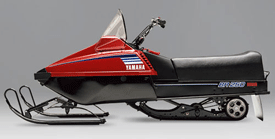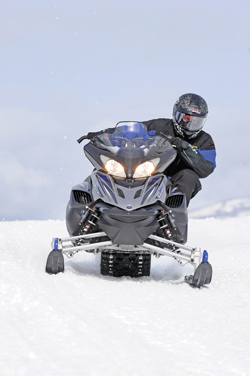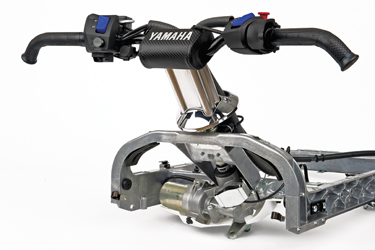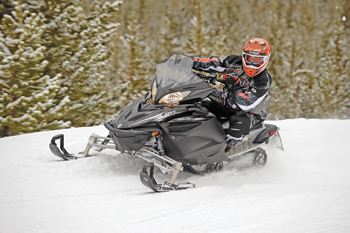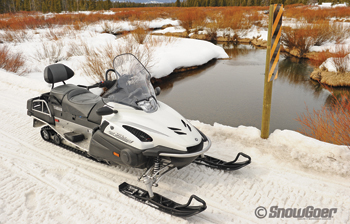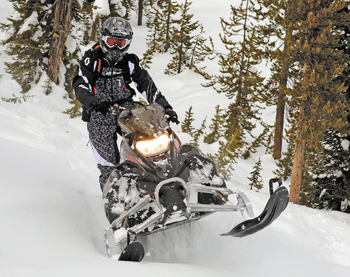Yamaha’s Best-Yet Four-Stroke?
Yamaha’s New FX Nytro XTX
Back in 2003 we named the Yamaha RX-1 the Snow Goer Snowmobile Of The Year because of its game-changing innovation: it was the first legitimate four-stroke sled. And while it was the latest and greatest a mere five years ago, new suspensions, chassis and four-stroke engines have been included in an aggressive snowmobile product plan.

We’ve claimed each new introduction is better than the last. The latest is the FX Nytro XTX crossover sled, and here we go again: It’s Yamaha’s best-ever four-stroke snowmobile.
The engine is the same Genesis 130 as in the rest of the FX Nytros. It puts out an honest 135 hp at 8200 rpm. As with the Nytro models last year, the engine pulls linear and smooth with an impressive midrange. A drag race against a short track Nytro would reveal any power differences, but from the driver’s seat the engine is equally quick and responsive and we couldn’t feel a power loss turning the longer, heavier track.
We were impressed with the FX Nytro debut last year but in production the chassis had shortcomings with its front-end handling. With the XTX debut comes new geometry that, when combined with the 144-inch track, settles the chassis.

Fidgety, unpredictable handling is no longer a glaring concern. Of the Nytros we tested at Rode Reports last spring, the XTX package was the best suspended. While all the Nytro models are more big-bump capable than the rest of Yamaha’s snowmobile line, the XTX has the best equipment list and configuration to produce the best bump performance with a blend of comfort and progression.

Though it has a longer track, Yamaha tipped the suspension rails so that in hardpack the footprint is the same as a 121-inch configuration. There’s nothing new with tipped rails, as Polaris did the same thing with its RMK and SwitchBack models several years prior. There is little, if any, extra front-end push from the longer track when going through corners on the Yamaha. The front end stayed flat and predictable. Obviously, there is more flotation for off-trail riding.
Off trail in the deep snow, we were disappointed with the climbing and boondocking performance. The FX Nytro XTX got stuck more often and in places where comparable two-stroke sleds – with shorter tracks – didn’t get stuck. It’s also worth noting that despite having more track on the ground, the weight and how it’s located makes deep snow flotation lag behind competitors.
Improved Nytro Handling
The other 2009 Nytro models got the updated front end to improve performance, too. Yamaha stated three goals for its 2009 Nytros: improve stability in bumps, improve handling and improve ride comfort.
To accomplish the upgraded handling are as many as 13 changes, depending on the model. All of them include new upper and lower A-arms, spindle changes, a revised sway bar, new tie rods and new upper ball joints.
One of the key handling revisions is the change to the spindle. The new geometry has about 0.6 inch more trail to make the front end more stable. To further give the Nytros more high-speed stability, the caster angle was increased from 22 to 25.8 degrees. The move increased the wheelbase and helps eliminate bump steer that made the front unpredictable on previous models.
It’s easy to quantify the improvement when comparing the 2009 to the 2008 models. We drove all the 2009 Nytros with more confidence, whether the corners were bumpy and slow or smooth and fast. It stays flatter and with far less of the bump steer that made the first Nytros unpredictable.

While more predictable and a better handler, there is a compromise. The Nytros steer fine but are slower to engage. The new sleds felt like more handlebar turn was required to make the front end navigate the line to the corner’s apex. We’ll happily trade the quickness downgrade in exchange for the added predictability, though. Any pushing or twitchiness from the front end is snow-condition sensitive and with adequate suspension adjustments, handling can be dialed in, but aggressive riders will want to search for a pair for aftermarket skis to make steering react quicker.
The Dual Shock CK rear suspension was updated, too. The spring rate was reduced while the rear spring preload was increased along with minor coupling changes. The goal was to improve the ride comfort in small and medium bumps. Yamaha’s suspension engineers also improved the center and rear shock calibrations for better bottoming resistance. The revised skid is fastened to the Nytro ER, Nytro RTX and Nytro RTX SE.

Without a 2008 model at Rode Reports to compare to the revised package, it is too difficult to gauge progress against the claims. Bottoming resistance is good and with an improved front end the whole suspension package is better, however. The Dual Shock CK rear suspension on short-track Nytro models is Yamaha’s best-performing skid, and any tweaks to improve it are a bonus.
The RTX SE package was a spring-order option that had an upgraded Dual Shock CK with reinforced torque arms and rails and an upgraded rear shock. A new Soqi 46mm rear track shock has adjustments for both high and low-speed compression damping with adjustable rebound. The revised skid is bolted in a more attractive, tapered tunnel with a Team Yamaha paint job. The ride is calibrated stiff for aggressive riding. With its full range of adjustability, the ride quality can be tuned for multiple riders over most terrain but the sled is more than intermediate riders need.
New RS Venture GT

The new RS Venture GT deluxe touring model started with the engine: the Genesis 120 EFI. In addition to the easier starting and drive-away and no-warmup_required EFI benefits, the engine weighs 2.2 pounds less and gets about five percent better economy than the 2008 Genesis 120 carbureted engine that powered the standard (and returning in 2009) RS Venture.
Yamaha also claims that even though the engine is calibrated for improved power and fuel economy, engineers squeezed another 6 peak horsepower from the plant. Based on a third-party dyno curve, the peak comes earlier and is less linear than the carbureted engine but the peak comes at the midrange where it will be most appreciated. Because of the demands of touring riders and their love of electrical gadgets, the engine has a new stator with 70 watts of additional electrical output.

Riders are better isolated from bumps with the Pro Comfort 144 rear suspension because of an upgraded, 40mm Soqi HPG clicker, remote reservoir shock and from an ergo change that puts riders more forward than the 2008 model.
Though there is good space in the cockpit for both driver and passenger, on sharp, full-lock turns, the elbows of the driver were obstructed by the knees of passengers. Though raising the bar height or tilting them forward might change driver comfort, it’s something owners might consider if they carry passengers whose legs are long. A shorter foot block for the passenger might alleviate it as well, but it would likely cause passenger discomfort and cause them to slide forward on the seat.

While a touring sled is not expected to rail through corners at reckless speeds, based on our past tests of other “GT” machines that were outfitted with the clicker shocks, we expected the Venture to corner flatter than it did. The notorious front end ills are something we’ve adjusted to on the previous Vector and Venture models, but the new Venture GT is built on the Delta Box II chassis – a chassis that manages the tippy feel. Not so on the RS Venture GT we tested at Rode Reports.
We voiced our surprise to Yamaha and were told the shocks on the test model were fresh out of the box and not properly calibrated. So, it appears we didn’t get a real impression of the ride quality the production model will offer. We expect the RS Venture GT to have the flat handling typically associated with Delta Box II chassis sleds.

Return Of The Apex ER
Yamaha said its dealers missed the Apex ER and its price point, so the sled returns after its absence in the 2008 product line. It’s relatively unchanged other than across-the-board updates to the Apex line, such as a new rear heat exchanger.
The 2009 Apex ER has only the essentials, yet it’s full-featured and has the Genesis 150FI engine, the Deltabox II chassis and the Mono Shock RA rear suspension.

We spent time on the Apex MTX and Nytro MTX mountain sleds as well at Rode Reports. The Apex MTX had its suspension upgraded with new aluminum HPG center and rear shocks calibrated for improved anti-bottoming and better ride comfort. We noted that on trails, the long sled cornered surprisingly well, but there’s still no hiding the big sled’s weight when attempting side-hills and aggressive powder carving. It¹s also at an obvious disadvantage when digging out.

As for the Nytro MTX, it returns with updates to the rear. Yamaha noted that trail sleds benefited from the new front geometry, but the mountain sled keeps the first generation setup because it’s better in off-trail situations. The new rear suspension is the ProMountain CK 153 and has a 3.5-degree tip-up on its rails and a new rear clicker shock.

